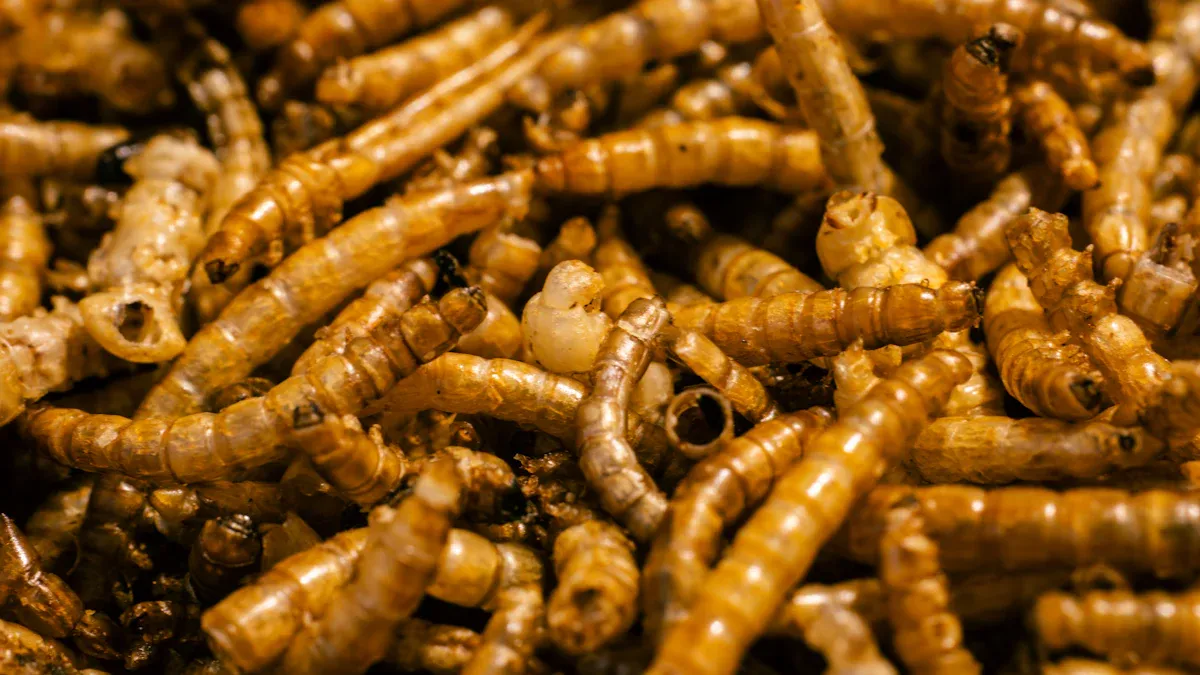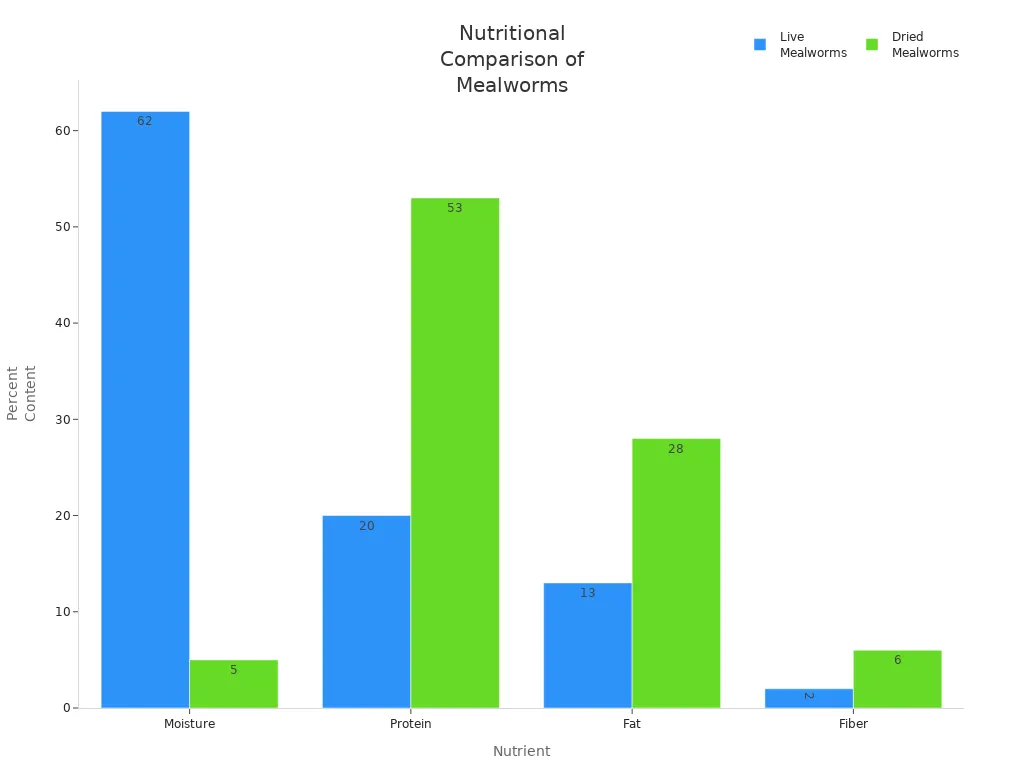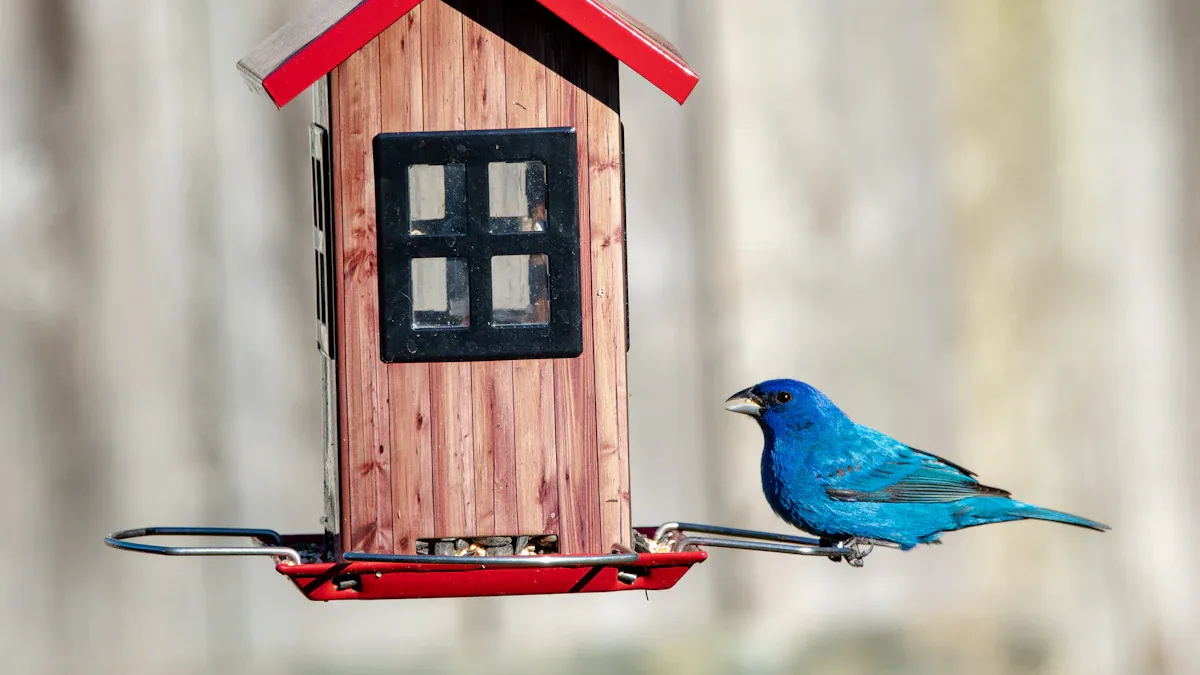
Dried mealworms for bluebirds help attract these colorful birds to backyard feeders. Many bird enthusiasts choose dried mealworms because they store easily, cost less than live mealworms, and support bird health. Studies show mealworm feeding often leads to healthier, more active bluebirds in home gardens.
Key Takeaways
- Dried mealworms offer an easy, long-lasting way to feed bluebirds and attract them to your yard without the need for special storage or care.
- Soak dried mealworms in warm water before feeding to make them softer and more appealing, and introduce them gradually alongside live mealworms for best results.
- Use bluebird-friendly feeders placed in open areas with fresh water nearby, and create a welcoming habitat with nesting boxes and native plants to support bluebird health and visits.
Why Dried Mealworms for Bluebirds Work

Convenience and Storage Advantages
Dried mealworms for bluebirds offer a simple way to attract these birds to any backyard. Many bird lovers choose dried mealworms because they are easy to store and last longer than live mealworms. People can keep dried mealworms in airtight containers, which helps prevent spoilage. Unlike live mealworms, dried ones do not need special care or refrigeration. This makes them a practical choice for families and schools.
The table below shows the main differences between storing live and dried mealworms:
| Aspect | Live Mealworms | Dried Mealworms |
|---|---|---|
| Storage Requirements | Must be refrigerated in breathable containers to keep dormant and fresh | Stored in airtight containers, preferably in freezer or refrigerator, away from heat, moisture, and light |
| Container Size | Small containers (16-24 oz) | Larger gallon-sized sealing bags |
| Shelf Life Factors | Refrigeration prolongs viability | Heat and moisture can cause rancidity; soaked dried mealworms must be used the same day due to short shelf life |
| Special Notes | Require fridge space but stay fresh longer | Soaked dried mealworms spoil quickly and develop odor |
Dried mealworms also save time. People can pour them directly into feeders without extra steps. This convenience encourages more people to feed bluebirds and enjoy their visits.
Nutritional Benefits and Limitations
Dried mealworms provide bluebirds with important nutrients. They contain high levels of protein and fat, which help birds stay active and healthy. During breeding season, bluebirds need extra energy and protein for nesting and raising chicks. Dried mealworms support these needs, especially when natural insects are hard to find.

The chart above shows that dried mealworms have more protein and fat than live mealworms, but less moisture. Bluebirds benefit from this energy boost, especially in cold weather or during migration. However, birds in the wild eat many types of food. Experts recommend using dried mealworms as a supplement, not the only food. Bluebirds need a balanced diet to stay healthy.
Tip: Rehydrating dried mealworms by soaking them in warm water makes them easier for bluebirds to eat and helps add back some moisture.
Dried mealworms for bluebirds work best when offered alongside other foods and fresh water. This approach helps attract bluebirds and supports their health year-round.
How to Introduce Dried Mealworms for Bluebirds
Rehydrating Dried Mealworms for Better Acceptance
Bluebirds often prefer live mealworms because they contain moisture. Dried mealworms for bluebirds can become more appealing when rehydrated. Soaking dried mealworms in hot water for about 15 minutes helps restore some of their lost moisture. Some bird enthusiasts also use a few drops of vegetable oil to soften the mealworms. This process makes the mealworms easier for bluebirds to eat and digest.
Tip: Always drain excess water before placing rehydrated mealworms in the feeder to prevent spoilage.
Songbird rehabbers have observed that feeding only dry mealworms may cause dehydration or digestive issues, especially in young birds. Rehydrating dried mealworms supports bluebird health and encourages them to try this new food source. Many backyard birdwatchers report that bluebirds quickly accept rehydrated mealworms, sometimes within minutes of their first introduction.
Transitioning Bluebirds from Live to Dried Mealworms
Introducing dried mealworms to bluebirds works best with a gradual approach. Bluebirds may accept dried mealworms quickly, but a few simple steps can help ensure success:
- Start by offering a small amount of dried mealworms mixed with live mealworms. Place the mix in a feeder that bluebirds already use.
- Gradually increase the amount of dried mealworms while reducing the live ones over several days.
- Use a feeder with high sides (1.5 to 2 inches) to keep mealworms contained.
- Place the feeder in an open area where bluebirds can see it from their favorite perches or nesting boxes.
- Move the feeder closer to its final location each day if starting near the ground.
- Offer mealworms at the same time each day to help bluebirds form a routine.
- Use a light-colored or contrasting feeder dish to make the food more visible.
- Try using a signal, such as a whistle or gentle tapping, to call bluebirds at feeding time.
Bluebirds often respond quickly to these methods. Birdwatchers have seen bluebirds begin eating dried mealworms within minutes to a few hours after introduction. Consistent feeding and observation help bluebirds adjust to the new food. Always choose high-quality dried mealworms from reputable sources to ensure safety and nutrition.
Note: Provide fresh water near the feeder to help bluebirds stay hydrated, especially when offering dried foods.
A gradual transition and careful observation help bluebirds accept dried mealworms as a regular part of their diet. This approach supports their health and encourages frequent visits to your yard.
Choosing and Setting Up a Bluebird Feeder

Selecting a Feeder for Dried Mealworms for Bluebirds
A well-designed feeder helps bluebirds access food while keeping out larger, aggressive birds. Many bird experts recommend feeders with a cage made from vinyl-coated wire mesh. The mesh openings should measure just under 1.5 inches wide. This size allows bluebirds and wrens to enter but keeps starlings away. Some feeders use a deep, wide container inside the cage to hold dried mealworms for bluebirds. This design prevents mealworms from spilling and makes feeding easier for bluebirds.
Other important features include:
- Tall sides to keep mealworms from escaping.
- A roof or rain guard to protect food from moisture.
- Drainage holes to prevent water buildup and mold.
- Tamper-resistant parts to keep squirrels out.
- Removable tops for easy cleaning and refilling.
- Temporary perches, such as twigs, to help bluebirds learn to use the feeder.
Feeders like the Perky-Pet Dried Mealworm Feeder with Flexports® and handmade red cedar feeders with small entry holes work well. These feeders balance easy access for bluebirds with protection from competitors.
Placement Tips to Attract Bluebirds and Deter Other Birds
Proper placement increases bluebird visits and reduces competition. Place the feeder away from clusters of other feeders. A distance of about 20 feet helps bluebirds feed peacefully. Hanging the feeder in an open area gives bluebirds a clear view and easy access. Using a starling-proof feeder, such as the Erva Mealworm Feeder, further limits unwanted visitors.
Some birdwatchers group feeders by type and species, spacing them apart to reduce crowding. Observing bird behavior at feeders helps identify the best spots for bluebirds. Adjusting feeder locations based on these observations can improve feeding success with dried mealworms for bluebirds.
Feeding Routine for Dried Mealworms for Bluebirds
Best Times and Frequency for Feeding
Bluebirds visit feeders most often in the early morning and late afternoon. Field observations show that these times match the birds’ natural feeding patterns. Many bird experts, including those from the North American Bluebird Society, recommend offering dried mealworms for bluebirds once or twice daily. Morning feedings help bluebirds recover energy after a long night. Evening feedings give them extra nutrition before roosting.
A regular schedule helps bluebirds learn when to visit. Consistency also supports incubating females and nestlings, especially during cold or rainy weather. Feeding at the same times each day encourages bluebirds to return and reduces the chance of food sitting out too long.
Tip: Place mealworms in the feeder just before sunrise and again in the late afternoon for best results.
Portion Control and Preventing Waste
Proper portion sizes keep bluebirds healthy and prevent food waste. Birding experts suggest offering about 100 dried mealworms per day for a pair of bluebirds, especially during nesting season. This amount gives enough protein without causing overfeeding. Too many mealworms can lead to health problems and attract unwanted pests.
Bluebirds eat dried mealworms quickly when they recognize the feeder. If mealworms remain after an hour, reduce the amount next time. If the feeder empties in minutes, add a few more mealworms at the next feeding. Adjusting the portion based on how fast bluebirds eat helps avoid waste and keeps the feeding area clean.
A simple table can help track feeding amounts:
| Day | Morning Portion | Evening Portion | Total Mealworms Offered | Mealworms Left |
|---|---|---|---|---|
| Monday | 50 | 50 | 100 | 10 |
| Tuesday | 40 | 60 | 100 | 0 |
| Wednesday | 60 | 40 | 100 | 5 |
Soaking dried mealworms in warm water for 10-30 minutes before feeding makes them easier for bluebirds to eat. This step is important during dry weather or when feeding fledglings. Clean the feeder often to prevent disease and spoilage.
Note: Dried mealworms for bluebirds work best as a supplement. Offer other foods like suet, sunflower hearts, or soft fruits to support a balanced diet.
Troubleshooting Dried Mealworms for Bluebirds
What to Do if Bluebirds Ignore Dried Mealworms
Sometimes bluebirds do not eat dried mealworms right away. Birdwatchers can use several strategies to encourage bluebirds to try this food.
- Start by offering live mealworms, which bluebirds find more appealing.
- Mix a small number of dried mealworms with live ones in the feeder.
- Gradually increase the amount of dried mealworms while reducing live ones over several days.
- Soak dried mealworms in hot water for about an hour to make them softer and more attractive.
- Keep a regular feeding schedule and use feeders that prevent mealworms from escaping.
Patience is important. Bluebirds may take time to adjust to new foods. Many people find that bluebirds accept dried mealworms after a few days of this routine. Using high-quality dried mealworms, such as those stored in airtight containers, helps maintain freshness and appeal.
Tip: Avoid overfeeding. Offer about 100 dried mealworms per day for a pair of bluebirds with nestlings.
Preventing Starlings and Other Unwanted Birds
Starlings and other large birds often compete for mealworms. Several methods help keep these birds away from bluebird feeders:
- Use feeders with entrance holes sized for bluebirds but too small for starlings.
- Choose enclosed feeders or those with cages to block larger birds.
- Serve mealworms in shallow, smooth-sided dishes to limit access.
- Train bluebirds to feed at consistent times, especially early in the morning.
- Keep food off the ground to reduce visits from unwanted birds.
- Place feeders away from seed feeders to avoid attracting mixed flocks.
Some bird lovers also use visual deterrents, like shiny mylar balloons, to scare off starlings. With the right feeder and routine, bluebirds can enjoy dried mealworms without much competition.
Enhancing Your Bluebird Feeding Experience
Using Sound Cues to Attract Bluebirds
Bluebirds respond well to certain sounds. Many birdwatchers use gentle whistles or tapping noises to signal feeding time. Over several days, bluebirds learn to associate these sounds with food. This technique helps train bluebirds to visit feeders at regular times. Some people also use blue-colored feeders, which attract bluebirds because their vision is tuned to blue and purple hues. Blue feeders stand out in the yard and make it easier for bluebirds to spot food from a distance.
- Use a consistent sound, like a whistle or tapping, before placing mealworms in the feeder.
- Choose blue feeders to catch bluebirds’ attention.
- Place feeders in open areas for better visibility.
Tip: Bluebirds often visit more when they recognize both a sound cue and a familiar feeder color.
Offering Water Alongside Dried Mealworms
Water is essential for bluebird health. Birds need water for drinking, bathing, and keeping their feathers clean. A clean bird bath near the feeder encourages bluebirds to visit more often. Fresh water supports their metabolism and helps them stay cool in warm weather. During winter, an unfrozen water source becomes even more important.
- Place a shallow bird bath near the feeder.
- Change the water daily to keep it clean.
- Use a heated bird bath in cold months to prevent freezing.
Providing both dried mealworms and water creates a welcoming spot for bluebirds and supports their well-being.
Creating a Bluebird-Friendly Habitat
A good habitat attracts more bluebirds and helps them thrive. Bluebirds prefer open spaces with short grass and scattered trees. Nesting boxes mounted on poles about five feet high offer safe shelter. Boxes should have ventilation, drainage, and predator guards. Native berry bushes like dogwood, holly, and sumac provide natural food, especially in winter.
- Install nesting boxes with overhangs and baffles.
- Plant native berry-producing shrubs and trees.
- Maintain open grassy areas with scattered perches.
- Avoid pesticides to protect insect food sources.
- Space nesting boxes at least 300 feet apart.
A well-designed habitat, combined with dried mealworms and water, gives bluebirds everything they need to visit and stay in your yard.
Dried mealworms for bluebirds offer a practical way to attract these birds and support their health. Birdwatchers notice several long-term benefits:
- Bluebirds grow stronger during harsh weather.
- Regular feeding encourages frequent visits.
- Proper feeder setup and moderate feeding help maintain natural behaviors and reduce waste.
FAQ
How long do dried mealworms stay fresh?
Dried mealworms stay fresh for several months in an airtight container. Store them in a cool, dry place to keep them safe for bluebirds.
Can dried mealworms replace live mealworms for bluebirds?
Dried mealworms work well as a supplement. Bluebirds may prefer live mealworms, but dried mealworms offer convenience and easy storage for bird lovers.
What is the best way to serve dried mealworms to bluebirds?
Place dried mealworms in a bluebird-friendly feeder. Soak them in warm water for 10–15 minutes to make them easier for bluebirds to eat.


